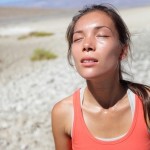Caution: Heat Stress

Ah, the warm weather is finally here—after what always feels like a way-too-long winter. These days, all I want to do is to be outdoors. For myself, that will entail walking, biking, hiking, golfing, and hopefully some kayaking and stand up paddle boarding. Others of you might “hit the ground running,” jumping, and playing all other manner of sports. But a beautifully warm, sunny day can turn into a deadly situation if we don’t take precautions.
The effect of temperature on our bodies can be altered dramatically if high heat is accompanied by high humidity. The extra moisture in the air inhibits the amount of “sweat evaporation” which can occur from our skin’s surface—our God-designed cooling process. Without the ability to cool the skin’s surface, your body’s internal temperature can quickly rise to unsafe levels.
One way to keep from overheating is to apply water, cool packs, or moist cooling towels to your neck/head. This direct cooling method is quite effective in keeping the body temperature in a safe range.
Secondly, adequate hydration is critical: before, during, and after outdoor activity. Water is a great beverage to hydrate with, but when physical activity is extreme or prolonged, additional beverages containing crucial salts and electrolytes will be important to replenish the body’s blood chemistry. If your frequency of urination is significantly diminished or if the shade of your urine darkens to a strong yellow, increase the amount of fluid you are consuming.
Another component of staying cool is to use the principle of shade—which can lower the temperature by 10-20 degrees! Take breaks in the shade, wear a brimmed hat to shade your face, and use a “sun-brella” if sitting in the direct sun as a spectator.
Signs of overheating change with its severity, becoming increasingly more serious.
- Heat cramps: painful muscle cramps in legs or abdomen, heavy sweating.
- Heat exhaustion: add to the above weakness, cool/pale/clammy skin, fast/ weak pulse, dizziness, nausea/vomiting, headache, fainting.
- Heat stroke: Throbbing headache, confusion, sweating has stopped/dry skin, nausea/vomiting, dizziness, body temperature above 103°F/hot/red, skin, rapid/strong pulse, loss of consciousness.
So, take heed, and if you or someone else is doing poorly, call 911!